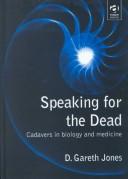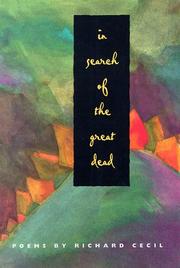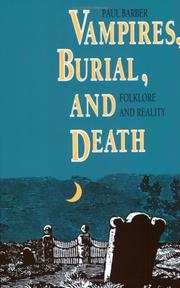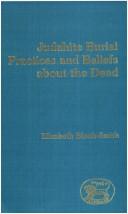| Listing 1 - 10 of 17 | << page >> |
Sort by
|

ISBN: 0754620735 Year: 2000 Publisher: Aldershot Ashgate
Abstract | Keywords | Export | Availability | Bookmark
 Loading...
Loading...Choose an application
- Reference Manager
- EndNote
- RefWorks (Direct export to RefWorks)
This text discusses issues in the use of human cadavers and tissues in science and medicine. Areas examined include the use of biopsies from surgical operations, the ethics of using human DNA and stem cells in research and the transplantation of animal tissue into humans. This text explores issues surrounding the use of human cadavers and human tissues in science and medicine. This is an area of increasing significance in contemporary society, as more and more techniques become available for manipulating human genes and human material (including embryos, body organs and brain tissue). These issues are explored through case studies from contemporary society. Some of the most topical issues examined include plastination of human bodies as an art form, the use of biopsies from surgical operations, the ethics of using human DNA and stem cells in research, and the debate surrounding the transplantation of animal tissue and organs into humans.
Dead --- Moral and ethical aspects --- Social aspects --- Cadavers --- Corpses --- Deceased --- Human remains --- Remains, Human --- Death --- Burial --- Corpse removals --- Cremation --- Cryomation --- Death notices --- Embalming --- Funeral rites and ceremonies --- Obituaries

ISBN: 0809385112 1299050727 0585333963 9780585333960 0809322609 9780809322602 9780809385119 Year: 1999 Publisher: Carbondale : Crab Orchard Review : Southern Illinois University Press,
Abstract | Keywords | Export | Availability | Bookmark
 Loading...
Loading...Choose an application
- Reference Manager
- EndNote
- RefWorks (Direct export to RefWorks)
With grim humor and humorous grimness, In Search of the Great Dead engages the great themes of poetry: death and fame. The title poem of this collection records Richard Cecil's quest for the tombs of the famous dead. At first the search leads him on a tour of famous European tombstones-the grave of Chateaubriand in St. Malo, the shared tomb of Gertrude Stein and Alice B. Toklas in Pere-Lachaise cemetery in Paris, Yeats's old Celtic cross in Sligo-but gradually it expands into areas where all the tombs have been erased by time or vandalism-the tombs of
Dead --- Cadavers --- Corpses --- Deceased --- Human remains --- Remains, Human --- Death --- Burial --- Corpse removals --- Cremation --- Cryomation --- Death notices --- Embalming --- Funeral rites and ceremonies --- Obituaries

ISBN: 0300041268 0300048599 Year: 1988 Publisher: New Haven London Yale University Press
Abstract | Keywords | Export | Availability | Bookmark
 Loading...
Loading...Choose an application
- Reference Manager
- EndNote
- RefWorks (Direct export to RefWorks)
Folklore --- Vampiers --- Vampires --- Dead --- -Postmortem changes --- -Vampires --- Animals, Mythical --- Superstition --- Change, Postmortem --- Change after death --- Changes, Postmortem --- Changes after death --- Post-mortem changes --- Death (Biology) --- Decomposition (Chemistry) --- Cadavers --- Corpses --- Deceased --- Human remains --- Remains, Human --- Death --- Burial --- Corpse removals --- Cremation --- Death notices --- Embalming --- Funeral rites and ceremonies --- Obituaries --- Postmortem changes --- Dead (in religion, folk-lore, etc.) --- Anthropology --- Social Sciences --- Lesbian vampires --- Monsters
Book
ISBN: 030022771X 9780300227710 0300221541 9780300221541 Year: 2017 Publisher: New Haven London
Abstract | Keywords | Export | Availability | Bookmark
 Loading...
Loading...Choose an application
- Reference Manager
- EndNote
- RefWorks (Direct export to RefWorks)
Do the dead have rights? In a persuasive argument, Don Herzog makes the case that the deceased's interests should be protected This is a delightfully deceptive works that start out with a simple, seemingly arcane question-can you libel or slander the dead?-and develops it outward, tackling larger and larger implications, until it ends up straddling the borders between law, culture, philosophy, and the meaning of life. A full answer to this question requires legal scholar Don Herzog to consider what tort law is actually designed to protect, what differences death makes-and what differences it doesn't-and why we value what we value. Herzog is one of those rare scholarly writers who can make the most abstract argument compelling and entertaining.
Dead. --- Human rights. --- Basic rights --- Civil rights (International law) --- Human rights --- Rights, Human --- Rights of man --- Human security --- Transitional justice --- Truth commissions --- Cadavers --- Corpses --- Deceased --- Human remains --- Remains, Human --- Death --- Burial --- Corpse removals --- Cremation --- Cryomation --- Death notices --- Embalming --- Funeral rites and ceremonies --- Obituaries --- Law and legislation
Book
ISBN: 9789004315143 9004315144 9789004358331 9004358331 Year: 2018 Publisher: Leiden Boston
Abstract | Keywords | Export | Availability | Bookmark
 Loading...
Loading...Choose an application
- Reference Manager
- EndNote
- RefWorks (Direct export to RefWorks)
Death was a constant, visible presence in medieval and renaissance Europe. Yet, the acknowledgement of death did not necessarily amount to an acceptance of its finality. Whether they were commoners, clergy, aristocrats, or kings, the dead continued to function literally as integrated members of their communities long after they were laid to rest in their graves. From stories of revenants bringing pleas from Purgatory to the living, to the practical uses and regulation of burial space; from the tradition of the ars moriendi, to the depiction of death on the stage; and from the making of martyrs, to funerals for the rich and poor, this volume examines how communities dealt with their dead as continual, albeit non-living members.
Death --- Funeral rites and ceremonies --- Dead --- History. --- Europe --- History --- Dying --- End of life --- Life --- Terminal care --- Terminally ill --- Thanatology --- Cadavers --- Corpses --- Deceased --- Human remains --- Remains, Human --- Burial --- Corpse removals --- Cremation --- Death notices --- Embalming --- Obituaries --- Funerals --- Mortuary ceremonies --- Obsequies --- Manners and customs --- Rites and ceremonies --- Mourning customs --- Philosophy --- E-books --- Dead. --- Death. --- Funeral rites and ceremonies. --- 476-1517 --- Europe. --- Cryomation --- Council of Europe countries --- Eastern Hemisphere --- Eurasia
Book
ISBN: 9781526129338 1526129337 9781526108180 1526108186 9781526120694 1526120690 1526107384 9781526107381 9781526108197 1526108194 Year: 2016 Publisher: Manchester Manchester University Press
Abstract | Keywords | Export | Availability | Bookmark
 Loading...
Loading...Choose an application
- Reference Manager
- EndNote
- RefWorks (Direct export to RefWorks)
Whether reburied, concealed, stored, abandoned or publicly displayed, human remains raise a vast number of questions regarding social, legal and ethical uses by communities, public institutions and civil society organisations. This work presents a ground-breaking account of the treatment and commemoration of dead bodies resulting from incidents of genocide and mass violence. Through a range of international case studies across multiple continents, it explores the effect of dead bodies or body parts on various political, cultural and religious practices. Multidisciplinary in scope, it will appeal to readers interested in this crucial phase of post-conflict reconciliation, including students and researchers of history, anthropology, sociology, archaeology, law, politics and modern warfare.
Human remains (Archaeology) --- Dead --- Victims of violent crimes. --- Genocide --- Social aspects. --- Sociological aspects. --- Skeletal remains (Archaeology) --- Human skeleton --- Primate remains (Archaeology) --- Sociology of genocide --- Sociology --- Victims of violence --- Victims of crimes --- Violent crimes --- Cadavers --- Corpses --- Deceased --- Human remains --- Remains, Human --- Death --- Burial --- Corpse removals --- Cremation --- Cryomation --- Death notices --- Embalming --- Funeral rites and ceremonies --- Obituaries --- Bioarchaeology --- Anthropology --- Archaeology --- War Crimes --- death --- exhumation --- human remains --- post-conflict --- modern warfare --- mass violence --- burial --- violence --- forensics --- Alsace --- Cadaver --- Germany --- Herero people --- Nazism --- The Holocaust
Book
ISBN: 1589017137 9781589017139 9781589016958 1589016955 Year: 2010 Publisher: Washington, D.C. : Georgetown University Press,
Abstract | Keywords | Export | Availability | Bookmark
 Loading...
Loading...Choose an application
- Reference Manager
- EndNote
- RefWorks (Direct export to RefWorks)
This volume chronicles not only a human corpse's physical state but also its legal and moral status, including what rights, if any, the corpse possesses. The author argues that a corpse maintains a "quasi-human status" granting it certain protected rights-both legal and moral. One of a corpse's purported rights is to have its predecessor's disposal choices upheld. This work reviews unconventional ways in which a person can extend a personal legacy via their corpse's role in medical education, scientific research, or tissue transplantation. The author outlines the limits that post-mortem "human dignity" poses upon disposal options, particularly the use of a cadaver or its parts in educational or artistic displays. Contemporary illustrations of these complex issues abound.
Sacrilege. --- Offenses against the person. --- Burial laws. --- Dead --- Human body --- Dead bodies (Law) --- Church desecration --- Desecration --- Offenses against religion --- Host desecration accusation --- Taboo --- Abuse of persons --- Crimes against persons --- Crimes against the person --- Offenses against persons --- Crime --- Persons --- Burial --- Mortuary law --- Cemeteries --- Undertakers and undertaking --- Cadavers --- Corpses --- Deceased --- Human remains --- Remains, Human --- Death --- Corpse removals --- Cremation --- Cryomation --- Death notices --- Embalming --- Funeral rites and ceremonies --- Obituaries --- Law --- Legal status, laws, etc. --- Law and legislation. --- Law and legislation --- Dead bodies (Law).
Book
ISBN: 1501703471 9781501703478 9781501702617 1501702610 9781501703461 1501703463 Year: 2016 Publisher: Ithaca, New York ; London, [England] : Cornell University Press,
Abstract | Keywords | Export | Availability | Bookmark
 Loading...
Loading...Choose an application
- Reference Manager
- EndNote
- RefWorks (Direct export to RefWorks)
Simultaneously real and unreal, the dead are people, yet they are not. The society of medieval Europe developed a rich set of imaginative traditions about death and the afterlife, using the dead as a point of entry for thinking about the self, regeneration, and loss. These macabre preoccupations are evident in the widespread popularity of stories about the returned dead, who interacted with the living both as disembodied spirits and as living corpses or revenants. In Afterlives, Nancy Mandeville Caciola explores this extraordinary phenomenon of the living's relationship with the dead in Europe during the five hundred years after the year 1000.Caciola considers both Christian and pagan beliefs, showing how certain traditions survived and evolved over time, and how attitudes both diverged and overlapped through different contexts and social strata. As she shows, the intersection of Christian eschatology with various pagan afterlife imaginings-from the classical paganisms of the Mediterranean to the Germanic, Celtic, Slavic, and Scandinavian paganisms indigenous to northern Europe-brought new cultural values about the dead into the Christian fold as Christianity spread across Europe. Indeed, the Church proved surprisingly open to these influences, absorbing new images of death and afterlife in unpredictable fashion. Over time, however, the persistence of regional cultures and beliefs would be counterbalanced by the effects of an increasingly centralized Church hierarchy. Through it all, one thing remained constant: the deep desire in medieval people to bring together the living and the dead into a single community enduring across the generations.
Future life --- Dead --- Death in popular culture --- Cadavers --- Corpses --- Deceased --- Human remains --- Remains, Human --- Death --- Burial --- Corpse removals --- Cremation --- Cryomation --- Death notices --- Embalming --- Funeral rites and ceremonies --- Obituaries --- Popular culture --- Afterlife --- Eternal life --- Life, Future --- Life after death --- Eschatology --- Eternity --- Immortality --- Near-death experiences --- Christianity --- History of doctrines --- Mythology --- History --- Religious aspects --- Death in popular culture - Europe - History - Middle Ages, 600-1500 --- Dead - Mythology - Europe --- Future life - Christianity - History of doctrines - Middle Ages, 600-1500 --- Mort --- Moyen Age

ISBN: 128180360X 9786611803605 0567506231 9780567506238 1850753350 9781850753353 6611803602 Year: 1992 Publisher: Sheffield, England JSOT Press
Abstract | Keywords | Export | Availability | Bookmark
 Loading...
Loading...Choose an application
- Reference Manager
- EndNote
- RefWorks (Direct export to RefWorks)
The family tomb as a physical claim to the patrimony, the attributed powers of the dead and the prospect of post-mortem veneration made the cult of the dead an integral aspect of the Judahite and Israelite society. Over 850 burials from throughout the southern Levant are examined to illustrate the Judahite form of burial and its development. Vessels for foods and liquids were of paramount importance in the afterlife, followed by jewellery with its protective powers. The cult of the dead began to be an unacceptable feature of the Jerusalem Yahwistic cult in the late eighth to seventh century BC
Burial --- Dead --- Tombs --- Burial customs --- Burying-grounds --- Graves --- Interment --- Archaeology --- Public health --- Coffins --- Funeral rites and ceremonies --- Grave digging --- Religious aspects --- Judaism. --- Palestine --- Antiquities. --- 393 <33> --- 393 <33> Dood. Dodengebruiken. Dodenritueel. Lijkverbranding. Begrafenis. Crematie. Rouw. Opbaren. Lijkstoet. Sterven. Dodenmaskers--Oud-Palestina. Judea --- Dood. Dodengebruiken. Dodenritueel. Lijkverbranding. Begrafenis. Crematie. Rouw. Opbaren. Lijkstoet. Sterven. Dodenmaskers--Oud-Palestina. Judea --- Cadavers --- Corpses --- Deceased --- Human remains --- Remains, Human --- Death --- Corpse removals --- Cremation --- Cryomation --- Death notices --- Embalming --- Obituaries --- Religious aspects&delete& --- Judaism
Book
ISBN: 1503607763 9781503607767 9780804791311 0804791317 9781503607750 1503607755 Year: 2018 Publisher: Stanford, California
Abstract | Keywords | Export | Availability | Bookmark
 Loading...
Loading...Choose an application
- Reference Manager
- EndNote
- RefWorks (Direct export to RefWorks)
Philosophy, Socrates declared, is the art of dying. This book underscores that it is also the art of learning to live and share the earth with those who have come before us. Burial, with its surrounding rituals, is the most ancient documented cultural-symbolic practice: all humans have developed techniques of caring for and communicating with the dead. The premise of Being with the Dead is that we can explore our lives with the dead as a cross-cultural existential a priori out of which the basic forms of historical consciousness emerge. Care for the dead is not just about the symbolic handling of mortal remains; it also points to a necropolitics, the social bond between the dead and living that holds societies together—a shared space or polis where the dead are maintained among the living. Moving from mortuary rituals to literary representations, from the problem of ancestrality to technologies of survival and intergenerational communication, Hans Ruin explores the epistemological, ethical, and ontological dimensions of what it means to be with the dead. His phenomenological approach to key sources in a range of fields gives us a new perspective on the human sciences as a whole.
Burial --- Dead. --- Funeral rites and ceremonies. --- Memory (Philosophy) --- Philosophy --- Funerals --- Mortuary ceremonies --- Obsequies --- Manners and customs --- Rites and ceremonies --- Cremation --- Cryomation --- Dead --- Mourning customs --- Cadavers --- Corpses --- Deceased --- Human remains --- Remains, Human --- Death --- Corpse removals --- Death notices --- Embalming --- Funeral rites and ceremonies --- Obituaries --- Burial customs --- Burying-grounds --- Graves --- Interment --- Archaeology --- Public health --- Coffins --- Grave digging --- Philosophy. --- Ancestrality. --- Anthropology. --- Archaeology. --- Burial. --- Death. --- Deconstruction. --- History. --- Memory. --- Necropolitics. --- Phenomenology. --- Memory (Philosophy).
| Listing 1 - 10 of 17 | << page >> |
Sort by
|

 Search
Search Feedback
Feedback About
About Help
Help News
News